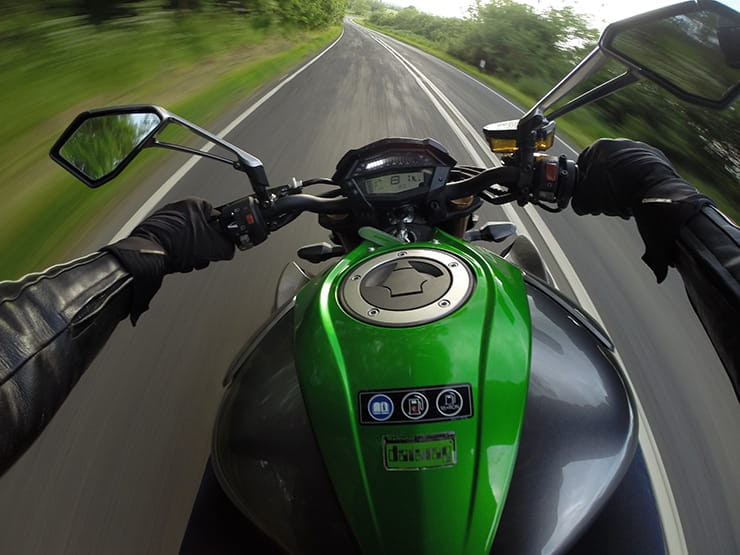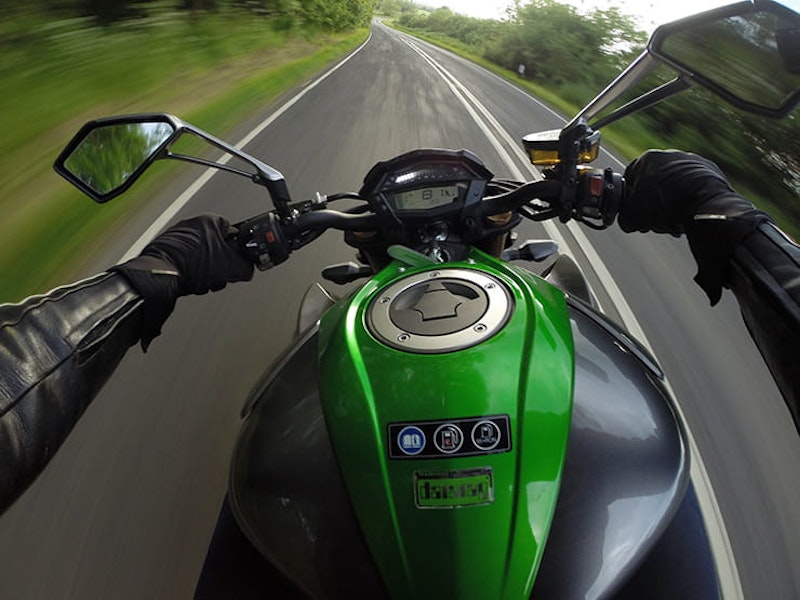Mike Abbott is this month’s instructor. He’s an ex-engineer, successful racer and hugely qualified trainer. He runs the British Superbike School, which has courses at tracks around the country. You can book on 01777 818013
His positioning here isn’t too bad, but he could be nearer the double white line. That would allow more vision, and possibly allow him to see if there’s a hazard currently obscured up on the left
When I was starting out, my instructor told me to ride near the middle of the road. Was he wrong?
You’re taught to ride down the centre of the lane to keep you away from hazards on either side – it’s safer to be in the middle if you’re wobbling. But there are risks with this position. If you’re in a row of traffic you’re almost invisible from in front and behind and you also have no clear escape route.
Explain the escape routes…
If a car does slam the brakes on, you have to waste time working out which way to escape - left or right. It’s much better to ride to the right (or left) of the lane so you don’t have to make that decision. If you’ve got an idea of where your escape route is at any moment, that can save you between half and one second.
Positioned for maximum visibility through the right-hander, but not riding in the gravel-strewn strip on the far left.
What about in corners?
If you want to ride in the middle of the lane and you’re comfortable with that, then it’s not a problem. It does compromise your view a bit, but if you go a bit slower that’s fine. Moving to the right on left handers and to the left on right-handers will mean you can go a bit quicker with the same degree of safety.
Are there risks to this positioning?
Yes. The danger with moving around to get the best view is what the following drivers are thinking. So you can get the classic situation where you move to the right to get a view round a left hander or maybe to see if you can overtake, and the guy behind thinks you’re going to turn right and moves up the inside. The same thing can happen when you move to the left to look down the inside of a vehicle you’re thinking of overtaking (to get a view). If there’s a junction coming up, the vehicle behind might think you’re going to turn left. You’ve got to keep checking your mirrors and doing your life-savers to make sure nothing’s pulled up next to you.
The escape route should anyone brake heavily is clear here – between the lines of traffic. If you’re in the centre of the lane, you have to decide which way to go in an emergency, which wastes time
So should I move about or not?
Definitely. You should be altering your position, changing your speed and making certain you’re in the right gear the whole time. We get a lot of people on our courses who ride at the speed limit in the middle of their lane. Riding behind, I can see all sorts of things happening ahead – a vehicle coming to a halt on the left, a zebra crossing with a central refuge with someone on it, a line of parked cars etc – and they don’t react. They just ride like an arrow at constant speed past the whole lot. It’s not surprising that so many riders get clobbered – they’re not aware of potential risks. They’re oblivious. And you can’t see something you’re not looking for.
So what should I be doing?
A better rider will be changing position, their head will be moving as they look around, their speed will be altering in preparation for what might happen. You’ve got to do a constant risk assessment, and position yourself where you would have the best outcome. Generally speaking, the biggest risk is vehicles coming in the opposite direction because the closing speed is doubled, so if you’re in doubt, stay away from oncoming traffic. Better you hit a car door that’s suddenly opened, than a vehicle coming the other way...

